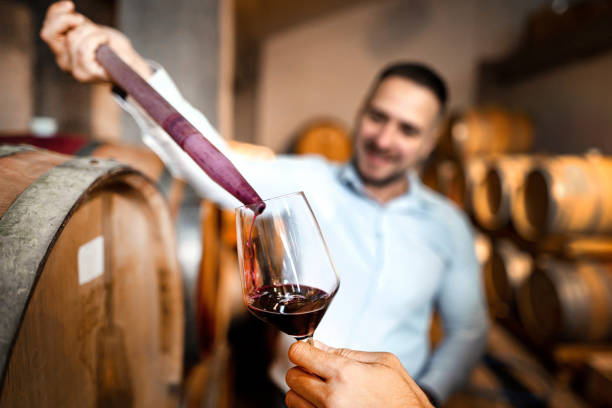The relationship between wine and food has produced an astonishing amount of literature. It is amazing how few ideas and opinions have been put under rigorous scientific examination. A few research papers discuss the subject. This could be due to their respective subject areas (enology and food sciences), which are in distinct departments. Furthermore, the sources of funding are distinct. For viticulture and enology, it is primarily derived from industry or government grants and is usually based on levies and taxes on wineries and vineyards. The funding for food science is mostly from commercial companies, which are largely run within the food industry itself, and the research is private. The funding from different industries offers very little incentive to collaborate on multidisciplinary projects, like the combination of wine and food.
A lot of the writing is written by people with an arts or scientific background. Sommeliers, for whom the combination of wine and food is their field, are more practitioners than researchers/academicians. This is why the subject has seen a slow decline without research-based rigorousness. It has been only recently that scientists have explored a topic that was previously the domain of the epicurean. Scientists, as innate doubters, need to be able to prove their theories through experimentation. This is a challenge since creating adequate controls is nearly impossible. Additionally, the conditions in the lab necessary for testing render the significance of comparing findings the correlation to “real life” situations dubious. When it comes to wine and food pairings, your social environment is usually more significant to the perception of the actual sensory clues. Additionally, social pressures frequently result in acceptance of alleged rules.
The following is a brief overview of combining wine and food and how to approach the subject with some certainty. It is also hoped that this article will provide “food for thought” to those who are seriously keen on wine.
The most common belief is that wine was in some way intended to be consumed in conjunction with food. However, if one searches for evidence, it is likely to be a fable, one that is that is so frequently repeated, it can be believed to be gospel–an instance of the social contagion that is a result of collective memory. Wine was the preferred drink of choice for eating throughout ancient Greek and Roman worlds. For the Near East and Egypt, wine was the solitary reserve of the religious and secular oligarchy. However, beer was the preferred drink of the working classes. It is mentioned throughout the Bible but is mostly recommended with regard to religious celebrations and weddings. It is only in the regions in which wild grapes were grown that the vines began to supply drinks for the masses. The acidity, alcohol, and phenolic content boosted its antimicrobial capacity, which makes it much healthier than water to drink. The mildly antiseptic properties of wine became more important as the population increased, hygiene conditions declined, and water resources were contaminated. Even though production was a seasonal affair (unlike beer made from dry grains), the wine’s superior ability to withstand spoilage (isolated from the air) allowed the wine to become the drink of choice. Furthermore, wine’s higher alcohol content can temporarily ease the pain of a life as a peasant. Although it’s safe and nutrient-rich (calorie abundant) however, there is nothing inherent in the characteristics of wine that make it a suitable drink for food. It’s actually more suitable to one of its earliest secondary uses, which is as being a solvent used in the preparation of extracts of medicinal herbal extracts.
The strong acidity of a lot of ancient wines, which are often augmented with vinegar and seawater that had been aged (especially to be used by slaves), cannot be thought of as a suitable food companion in any modern point of view. The sour flavor that was a result of the storage of amphoras in the standard manner (made watertight by a layer of pitch) is not likely to have helped the detection of any scents that might have. The quality of the standard wine that was available to the common Roman should be kept to the imagination. There were better wines available to the classes of the patrician. They probably were kept in amphoras that had an inner vitreous surface with no need for a pitch liner. The most well-known ones appear to have become very concentrated over time and were almost syrup-like, generally diluted prior to consumption. A number of Roman poets celebrated the splendors of certain vintages.
Modern wines that have a predominant acidic, bitter, and astringent characteristics do not suggest a food-friendly compatibility. These traits are the result of chemistry in grapes and not a conscious decision. Although drinking wine alongside food may help alleviate the unpleasant aspects of wine until one gains an appreciation for drinks that have a bitter/astringent component. Certain people are capable of recognizing and even desire perceptions initially aversion to pain. Capsicum peppers, black coffee durian, capsicums as well as Limburger cheese are all classic examples.
In some cases, the iron content of the wine may trigger an unpleasant metallic taste due to catalyzing the oxidation of lipids. It can be disguised in conjunction with food. However, this seems to be in no way related to the fishy aftertaste that’s associated with certain white wines consumed along with fish ( Tamura et al. 2009).
In many “compatible” combinations, both the wine and cheese appear superior, not directly by enhancing their qualities, but rather the mutual suppression of their less pleasant aspects ( Nygren et al. 2002, Nygren et al. 2003a, Nygren et al. 2003b). Some studies have further substantiated these findings, proving the notion that red wines go well with cheeses due to the tannins in wine appearing silkier ( Bastian et al. in, 2010). It is believed that the fatty acid composition in cheese can help reduce bitterness ( Homma et al. 2012) and possibly through covering taste receptors. Lipoproteins, which are typically present in foods, could interact with taste receptors, reducing the sense of bitterness ( Katsuragi et al. 1995). However, the bitter-suppressing properties of cheeses might also be due to their sodium content ( Frijters and Schifferstein 1994, Breslin and Beauchamp 1997, Keast et and. 2001) or the presence of glutamate or adenosine monophosphate ( Keast and Breslin 2002). The fruity flavor of wine could be enhanced when it is paired with cheddar cheese ( Galmarini et al. (2016)) .
While most wine and cheese associations appear beneficial in their mutual benefits, there are some that aren’t, like the sweet wine industry and cheese ( Bastian et al. 2009.). This compatibility is rooted in the elimination of unpleasant experiences might not be the way wine experts and sommeliers say; however, it is more plausible. This could also be applicable to numerous supposedly food-related as well as wine “marriages.”
Salt’s ability to neutralize bitterness ( Nakamura et al. 2002) may be the cause of the seemingly ancient practice of adding wine with seawater, e.g., Oinos and thalassikos ( Younger, 1966, page. 130). Pliny ( Historia Naturalis, 14.120) also mentions that salt improved the smoothness of wine. Columella ( De Res Rustica 12.41) suggests a salt addition, possibly to avoid the taste of mold. He also mentions salt in a recipe for making “Greek” wine. Saltwater was also utilized in the past to make new barrels that could be used to store wines ( Negre and Francot 1955).
Salt is widely known for its ability to enhance flavor. It could be used to break down weak, nonvolatile compounds between aromatic and matrix compounds, which can lead to their release and retronasal recognition ( Linscott and Lim 2016). Additionally, sodium ion hydration could reduce “free water,” changing the polarity of a solution. Salt increases the volatility of aromatics, however, but saltiness can be loved ( Bolhuis et al. 2016).




